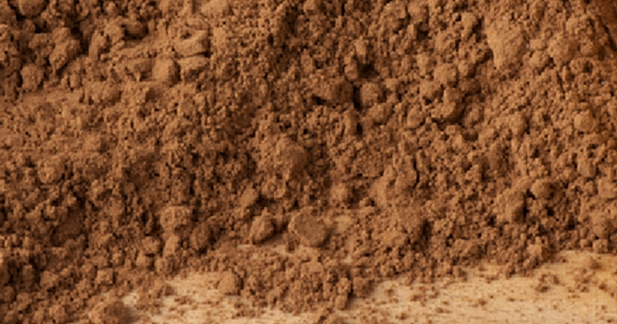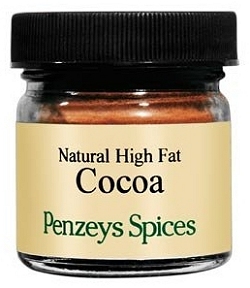
Penzeys Natural High Fat Cocoa Review
November 16, 2015
Sometimes I get asked, “Why does cocoa powder come in different shades of brown depending on the brand I buy?” This is a very good observation as cocoa powder comes in a range of colors from light brown to deep brown, from red to black, and many shades in between.
The general cocoa powder making process consists of squeezing out the cocoa butter after the cocoa beans are crushed into liquid form. This liquid, also known as chocolate liquor or unsweetened baking chocolate, is poured into a hydraulic press.
When the chocolate liquor is pressed, the cocoa butter is separated from the cocoa solids. The cocoa solids become hard cakes of cocoa which are then dried, broken apart, and pulverized into a powder.
Cocoa powder can be altered in ways that change the color, flavor, and functionality depending upon the product for which it is intended. Here’s where the manufacturer, or brand, may come up with their signature cocoa powder by manipulating the 
I’ve decided to review Penzeys Natural High Fat Cocoa powder by using it in a Chocolate Chia pudding recipe (click the link to see that post) that I’ve used many times with different cocoa powders in the recent past.
My goal is to see this particular cocoa’s color, taste its flavor, and make sure it behaves as expected. One could just as easily perform the same comparisons using a favorite cake or brownie recipe. Cooking with cocoa powder is the best way to discover which one you like and why.
Reading The Cocoa Powder Label
There’s meaning behind the words Natural High Fat Cocoa on the label. It is part of the U.S. FDA’s Standards of Identity (aka Truth in Labeling).
“Natural” and “High Fat” tell the consumer two important facts about the cocoa powder before they buy it. “Natural” means that the chocolate liquor is not processed with alkali/dutch-processed (I’ll explain shortly) and “High Fat” means the percentage of fat (cocoa butter) is between 22% – 24%.
High fat cocoa contains twice the fat percentage of low fat cocoa powder. Low Fat cocoa powder is between 10% - 12%. Most of the time, manufacturers of cocoa powder don’t display the percentage on the packaging, or even declare if it’s High Fat or Low Fat. Instead, this information is detailed on the nutritional label in grams per serving.
Similarly, the terms “Natural” or “Dutch-Processed” are not usually part of the marketing displayed on the packaging or wrapper, but can be found on the ingredient list. “Dutch-processed cocoa” or “cocoa processed with alkali” is the same thing. These words must appear on the ingredient label by law in the U.S. When cocoa is processed with alkali, it becomes darker, more bitter, and more alkaline in pH.
What Does This Really Mean?
So what if the label tells me that it’s high fat or that it’s natural and not processed with alkali? What does it really mean?
Fat delivers flavor. If you have a choice between a high fat cocoa and a low fat cocoa, a higher fat cocoa will taste richer, more “chocolatey”, more balanced. A low fat cocoa will have softer, muted chocolate notes. Side by side, a high fat cocoa will be slightly darker in color than a low fat cocoa but this because of the fat content, not because of any added alkali.
Alkali darkens and strips some flavor. If you have a choice between a natural cocoa and a Dutch-processed cocoa, a Natural cocoa will have a slightly sharp but bold chocolate flavor, and a light to medium brown color. A Dutch-processed cocoa will have a mellow, slightly bitter chocolate flavor and a range of darker colors from medium brown to red to black.
The Technical Side of “Dutched”
One more thing. There’s something “technical” I’d like to point out about Natural vs. Dutched. Natural cocoa is acidic, about 5.3 to 5.8 on the pH scale.
Adding alkali to natural cocoa will neutralize the acidity and bring the pH to around 7. Dutched cocoa is typically between 7.0 and 8.0 pH (a pH of 8 is indicative of a black cocoa. Black cocoa? Think Oreo cookie!).
The pH of cocoa is important in some cases. For instance, if you add natural cocoa to milk, the acidity can cause it to curdle. Using a lightly Dutched processed cocoa is best for making chocolate milk and chocolate ice cream.
Take a Look at Our Online Chocolate Class!
Back to the Review
Now, back to the matter of taste testing and reviewing the Penzeys Natural High Fat cocoa. The color of Penzeys Natural High Fat Cocoa is a gorgeous medium brown. The aroma has strong chocolate notes with a little hint of spice, wood, and vanilla.
Used in the chocolate chia seed pudding, the chocolate flavor stands out, but also blends nicely with the milk and brown sugar so that all the flavors take part in the mouth. The chia seed is neutral in flavor but creates a unique texture. The color is rich and makes the very pudding inviting!
You might be wondering if Penzeys sells a Dutched-Processed High Fat cocoa. According to their website, www.penzeys.com, yes! They sell both a Natural and a Dutched cocoa powder, and both are offered in the High Fat version.
You can bet I’ll be testing that one soon!
(Here's are comparison links for Amazon.com: 3 cup bag, 1.5 cup bag, 3/4 cup bag)
- BarkThins Dark Chocolate Coconut with Almonds - May 22, 2020
- Endangered Species Cacao Nibs + Dark Chocolate Review - May 15, 2020
- Mr. Dot Bar Review - May 7, 2020



Hello,
Can I assume that this cocoa powder doesn’t have any sugar in it?
Hi Bryn,
do you have knowledge of any full/whole fat cocoa powder in the market?
Cheers
Hello,
No, I do not know of any cocoa powder on the market that contains more than the “high fat” variety (22% – 24%).
I have a recipe calling for “raw cocoa”.” I am guessing this is the same as natural. What do you think? Thanks!
Hi Judy,
“Raw” is unroasted and minimally processed and is meant to differentiate it from roasted or highly processed. “Natural” is a term that means it was NOT “processed with an alkali”. In chocolate terminology, “raw cocoa” is NOT the same as “natural cocoa”. While it is highly unlikely that raw cocoa would be alkalized, it is most likely that natural cocoa was roasted first.
I hope this helps.
Bryn
This was very informative, thank you.
Many brands of cocoa/ chocolate have a percentage amount on the label. Would you be able to guesstimate the percentage in this product.
I have seen chocolate bars with the cocoa percentage on the label, and that’s because they show the amount of chocolate liquor in their formulation. This allows consumers to know how much “chocolate” is in the bar compared to sugar and other ingredients. I have not seen jars of cocoa powder with such a percentage because there isn’t any ingredient other than cocoa powder.
That said, do you mean you would like a guesstimate on the cocoa powder solids vs. cocoa butter ratio? If yes, you are asking a difficult question to answer. For this particular product (Penzeys High Fat Cocoa Powder), the term “High Fat” indicates between 22-24 percent cocoa butter, leaving the remainder to be 76-78 percent cocoa solids.
Please, I would like to Know about high fat cocoa and a low fat cocoa in relation to health. What is the better natural cocoa or high fat ?
Thanks, Julival Ribeiro
There are two types of cocoa powder; Natural Cocoa and Alkalized (Dutch Processed) Cocoa. Both can come in high fat and low fat varieties.
The alkalizing process may strip some of the beneficial flavanols from the cocoa. So, while I don’t have any research at my finger tips to tell you for certain, the general rule is food that goes through less processing is more beneficial for your health than food with more processing. So from a health perspective, use natural cocoa instead of alkalized cocoa. That would be my recommendation.